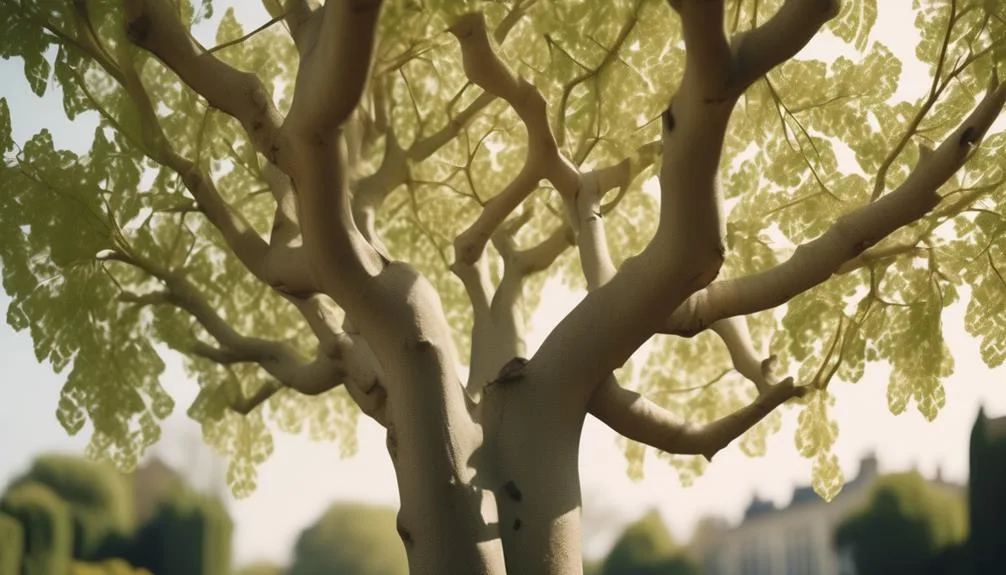Sycamore trees, known for their sprawling branches and large leaves, may seem untamable at first glance. Surprisingly, with the right techniques and consistent effort, they can be shaped into various forms, adding a unique touch to your landscape.
How can this be achieved, and what factors should you consider? Stay tuned to learn the secrets of shaping sycamore trees and the art of tree training.
Sycamore Tree Characteristics
Sycamore trees, known for their large, distinct leaves and mottled bark, are a common sight in many landscapes across North America. These trees are renowned for their rapid growth, often reaching heights of 70-100 feet with a spread of 40-70 feet. Their growth rate is impressive, adding 2 feet or more in height each year.
The bark of the sycamore tree is a true standout feature, characterized by its unique mottled pattern, with patches of white, gray, and brown. As the tree matures, the bark exfoliates in irregular sections, revealing the smooth, pale inner bark. This distinctive bark pattern makes the sycamore tree a striking addition to any landscape, providing visual interest year-round.
Pruning and Training Sycamore Trees
With their rapid growth and distinct bark, sycamore trees can be pruned and trained to create unique shapes and forms in your landscape. When it comes to sycamore tree growth, pruning is essential for maintaining their health and appearance. Regular pruning helps remove dead or diseased branches, promotes air circulation, and controls their size and shape.
To start, identify any damaged, crossing, or crowded branches for removal. Use sharp, clean tools to make precise cuts, ensuring the tree's natural form is preserved.
For shaping or training sycamore trees into specific forms, such as espalier or topiary, consider using techniques like selective pruning and staking. It's important to understand the specific pruning methods suitable for sycamore trees to achieve the desired shapes while maintaining their overall well-being.
Shaping Sycamore Trees: Techniques
Using proper pruning techniques is essential for shaping sycamore trees into desired forms, ensuring their healthy growth and aesthetic appeal in your landscape.
When it comes to tree sculpting, it's important to start when the tree is young to guide its growth. Begin by removing any competing or crossing branches to establish a strong central leader.
As the tree matures, selectively prune to encourage the desired shape, whether it's a classic canopy, an elegant column, or a unique artistic form. Creative landscaping with sycamore trees can involve techniques such as pollarding, which involves removing the upper branches to create a dense head, or pleaching, where branches are intertwined to form living fences or screens.
Remember to always use sharp, clean tools and to avoid over-pruning, as sycamores can be sensitive to excessive cutting.
Factors to Consider When Training Sycamore Trees
After establishing a strong central leader and selectively pruning to encourage the desired shape, the next step is to consider several important factors when training sycamore trees.
When implementing pruning techniques, always prioritize the tree's health. Prune during the dormant season to minimize stress on the tree and avoid excessive sap bleeding. Additionally, ensure that pruning cuts are clean to prevent the entry of diseases or pests.
Consider the tree's overall structure and growth pattern when determining the pruning regimen. Aim to maintain a balanced canopy to promote even sunlight exposure and airflow, which are crucial for the tree's health.
Regularly inspect the tree for signs of disease or damage, and adjust the training approach accordingly.
Maintenance of Shaped Sycamore Trees
To maintain the shape of your sycamore trees, regular pruning and monitoring for signs of disease or damage are essential. Proper tree shaping maintenance is crucial to ensure the health and longevity of your shaped trees.
When pruning, focus on removing any dead, diseased, or crossing branches to maintain the desired shape and encourage healthy growth. It's important to conduct regular inspections to identify any signs of disease, insect infestations, or structural issues. Promptly address any concerns to prevent them from affecting the overall health and appearance of your shaped trees.
Additionally, provide adequate care, including watering and mulching, to support the tree's overall well-being. By staying vigilant and providing proper care, you can enjoy the beauty of your shaped sycamore trees for years to come.
Conclusion
Incorporating shaping techniques, sycamore trees can be molded into various forms, adding a unique and artistic touch to any landscape. However, it's crucial to consider the tree's age, health, and natural growth pattern before pruning.
With regular maintenance, shaped sycamore trees can enhance the beauty of outdoor spaces. Consider the potential of shaping your sycamore tree to create a personalized and visually appealing environment.

My interest in trees started when I first saw the giant sequoias in Yosemite.
I was a teenager then, and I remember thinking, “I need to learn more about this.”
That moment stuck with me.
A few years later, I went on to study forestry at Michigan Tech.
Since graduating, I’ve worked in a mix of hands-on tree care and community education.
I’ve spent over ten years helping people understand how to plant, maintain, and protect the trees in their neighborhoods.
I don’t see trees as just part of the landscape.
They are living things that make a real difference in our daily lives.
